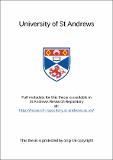Niobium based materials for use as current collectors in the anode of solid oxide fuel cells
Abstract
In this work I present the results of my studies on a series of reduced niobium based rutile structures: Nb₂TiO₇ doped with Fe and Zr, Ti₁₋₂ₓCrₓNbₓO₂ solid solution series. Strontium niobates of the stoichiometry Sr₄Nb₂O₉, Sr₂Nb₂O₇, Sr₂Nb₂O₆ and their reduced phases were also investigated, along with CaNb₂O₆ and BaNb₂O₆.
Thermal expansion and electronic conductivity of these materials were investigated under oxidising and reducing conditions. Nb₂TiO₇ goes to rutile structure Nb ₁.₃₃Ti₀.₆₇O₄ under reducing conditions, and this has the highest conductivity of all materials investigated at 300 Scm⁻¹ at 900°C with p(O₂)=10⁻²⁰ atm, but the lowest thermal expansion of 3.00±0.05x10⁻⁶ K⁻¹ (100°C-900°C), which is incompatible with the thermal expansion coefficient of the Ni/YSZ anode in the solid oxide fuel cell of 10.3x10⁻⁶ K⁻¹. Doping Nb ₁.₃₃Ti₀.₆₇O₄ decreases its conductivity, but increases its thermal expansion to a maximum of 6.3x10⁻⁶ K⁻¹ for Nb₁.₃₄₇Ti₀.₆₃₉Fe₀.₀₀₁₄O₄.
The Ti₁₋₂ₓCrₓNbₓO₂ solid solution series shows a maximum thermal expansion of 8.5x10⁻⁶ K⁻¹ for x=0.1 which then drops with increasing x to 5.6x10⁻⁶ K⁻¹ for x=0.5. The conductivity of these samples, however, reaches a maximum of ~20Scm⁻¹ at p(O₂)=10⁻²⁰ atm at 900°C for x=0.1-0.3, then drops to ~10 Scm⁻¹ for x=0.4 and -6 Scm⁻¹ for x=0.5.
Sr₄Nb₂O₉, Sr₂Nb₂O₇, SrNb₂O₆, CaNb₂O₆, and BaNb₂O₆, all show fairly poor electronic conductivities in air and 5%H₂/Ar (p(O₂)=10⁻²⁰ atm) at 900°C which make them unsuitable for use in the anode of the SOFC. Structurally they are very stable to reducing conditions up to 1200°-1300°C in 5% H₂/Ar compared to Nb₂TiO₇ whose structure changes to rutile upon reduction.
In the systems studied, there are two types of conductivity that dominate. BaNb₂O₆ or Sr₂Nb₂O₇ show a linear dependence over the p(O₂) range with simple defect equilibrium and fair kinetics. The rutile Ti₁₋₂ₓCrₓNbₓO₂ series, on the other hand, shows complex phase transitions throughout the p(O₂) range with kinetically limited reduction.
Type
Thesis, PhD Doctor of Philosopy
Collections
Items in the St Andrews Research Repository are protected by copyright, with all rights reserved, unless otherwise indicated.

